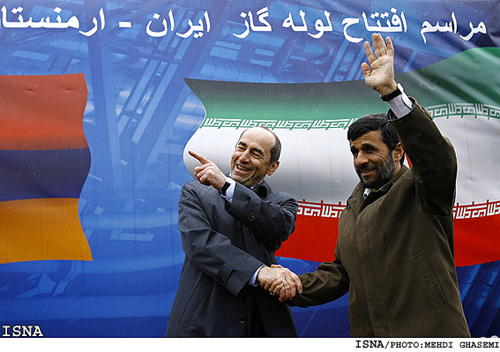
Armenia, Iran Forge Ahead With New Energy Projects
Publication: Eurasia Daily Monitor Volume: 7 Issue: 172
By:

Armenia and Iran are pressing ahead with the long-awaited implementation of fresh joint energy projects that will cement closer ties amid Tehran’s deepening standoff with the West. The two neighboring states are expected to start building, before the end of this year, two major hydro-electric plants on their border, a fuel pipeline and a third high-voltage transmission line connecting their power grids.
Armenian Energy and Natural Resources Minister, Armen Movsisian, announced on September 16 that work on the cascade of two plants, to be located on either bank of the Arax River marking the Armenian-Iranian border, will commence during his Iranian counterpart Majid Namju’s upcoming visit to Yerevan. Movsisian said each plant will cost more than $320 million and have a capacity of 130 megawatts, enough to increase Armenia’s current electricity output by more than 10 percent (Armenian Public Television, September 17).
Under a bilateral agreement formally approved by the Armenian government on September 13, these plants will be built by an Iranian company, Farad-Sepasad, during the next five years. In Movsisian’s view, Armenia will finance its share of the project with electricity to be generated by the Armenian plant and exported to Iran. It will need 15 years to recoup the Iranian investments, Movsisian said. A similar arrangement was reached on a $180 million pipeline designed to pump Iranian petrol and other oil products to Armenia at prices which Movsisian said will be well below international levels. The cash-strapped government in Yerevan is expected to receive a $90 million Iranian loan and repay it with proceeds from future Iranian fuel sales. Movsisian said in July that the pipeline’s construction will start this fall (www.armenialiberty.org, July 14).
Movsisian also announced in July that that the new Armenian-Iranian power transmission line will begin construction “within approximately one month.” The facility is essential for large-scale exports of Armenian electricity to Iran planned by the two governments. That electricity is due to be generated using Iranian natural gas which Armenia began importing, in modest amounts, in May 2009 through a newly built pipeline. The pipeline’s construction, completed in late 2008, marked an important milestone in the development of Armenian-Iranian relations, making Iran an alternative supplier of gas to the South Caucasus country still heavily dependent on Russian energy resources.
The three energy projects will only move those relations up a gear. Iran’s Foreign Minister, Manouchehr Mottaki, stressed their importance in an interview on September 2 with the Panarmenian.net news service. Mottaki stated that the two nations should go even further and sign a free trade agreement. Mottaki also spoke of “serious progress” in bilateral ties and Armenia’s “special place” in Iranian foreign policy, underlying a common belief that it is always motivated by shared concerns. The Iranian assistance to the cash-strapped government in Yerevan in realizing the projects is a measure of the Islamic Republic’s strong interest towards its sole Christian neighbor locked in a bitter dispute with Shia Muslim Azerbaijan.
Iranian President, Mahmoud Ahmadinejad, and Armenian Foreign Minister, Edward Nalbandian, expressed their “satisfaction with the multi-faceted cooperation between the two countries” and “readiness to develop it further” when they met in Tehran on September 15 (statement by the Armenian foreign ministry). Nalbandian also met with Mottaki and Saeed Jalili, the secretary of the country’s Supreme National Security Council, during the one-day trip. The official Iranian IRNA news agency quoted Mottaki as saying after the talks that the two sides are “determined to enhance the level of our political, economic and cultural cooperation.”
With the Karabakh conflict unresolved and the normalization of Turkish-Armenian relations still a long way off, the benefits of that cooperation for Yerevan are more than obvious. It secures an alternative source of vital gas supplies and a huge market for multiplying and exporting Armenia’s electricity surplus and, more importantly, eases the impact of the continuing Turkish and Azeri embargoes. “Iran is a country rich in energy resources,” Armenian President, Serzh Sargsyan, told the Ukrainian magazine Profil in an interview on September 17. “We do not have such resources and are cooperating in that area with pleasure.” Sargsyan again praised the “balanced” Iranian position on the Karabakh conflict, an Armenian euphemism for Tehran’s failure to lend unconditional and meaningful support to Azerbaijan (Profil, September 17).
Close ties with Iran have taken on another security dimension for Armenia in the past two years. Ever since the Russia-Georgia war in August 2008, the Islamic Republic has been the only more or less reliable supply line for Russian troops stationed in Armenia. A recent Russian-Armenian defense agreement extended their presence by 24 years, until 2044, and gave them a larger role in the landlocked country’s security. Iranian territory and airspace also seems the most realistic transit route for Russian weapons supplies to Armenia envisaged by the agreement.
In implementing the multimillion-dollar energy deals with Tehran, Yerevan is clearly undaunted by new, harsher, sanctions which the UN Security Council imposed on Iran in June over its controversial nuclear program. Armenian leaders have always avoided any criticism of Iranian nuclear ambitions, contenting themselves with general calls for a negotiated solution to the standoff. Visiting Germany this summer, Sargsyan suggested that the West will fail to lay its concerns to rest unless it addresses “Iran’s sense of being in danger.” “I am convinced that it is wrong and not possible to ignore Iran in regional solutions,” Sargsyan said (Hayastani Hanrapetutyun, June 23).




